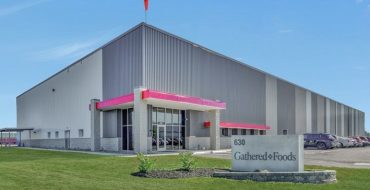
Gathered Foods Executive Chair Chris Kerr still hasn’t seen the place that has consumed a great amount of his thoughts and actions for the last two years, $20 million of his company’s funds and 42,500 square feet in an industrial park in Heath, Ohio.
But the founder and former CEO of the plant-based seafood company that makes Good Catch products will finally see the new custom-built factory next month. The factory, which was designed and built from the ground up for the company’s current and future production needs in the U.S., was completed during the pandemic, and has been making products since the end of May.
“I’m going to be driving to Chicago for a meeting, and I’m gonna stop there with my wife along the way. Crack a bottle of champagne,” Kerr said.
Custom designing and building the factory was a distinct challenge from the beginning, Kerr said. Getting it finished and starting up the equipment for the first time during a pandemic added another dimension to it. And since Good Catch leadership is decentralized — Kerr lives in central New York, the factory is in central Ohio, the chief operating officer lives in North Carolina and the technical team is in Vancouver, Canada — most of the company heads who were intimately involved with the factory couldn’t easily get there.
Kerr said that designing and building the factory, getting the equipment, creating the areas needed, hiring the employees, getting the permits and actually making products was a roller coaster ride. But the factory actually started running on its targeted opening day.
The role of technology
Kerr said he had many teams working with him that knew a lot more about building and commissioning a sophisticated food factory, and he leaned on them for their expertise in designing and outfitting the facility. It all worked well throughout the entire process, though the coronavirus outbreak and the related slowdown of activity made things more complicated.
The Gathered Foods team, which is located across the United States, had been accustomed to more remote contact prior to the pandemic — even though they all came together at a small hotel close to the plant on a regular basis when travel was easier. From the start, the factory was equipped with cameras that tie into Zoom, which can be monitored remotely by the technical team in Canada to ensure things are running smoothly. There are also cameras that some employees wear for more remote monitoring.
“Thank God technology exists,” Kerr said. “It allowed us to keep it going.”
As the threat of coronavirus first shut down schools, offices and restaurants across the country in March, Kerr also shut down construction and setting up the new plant for two weeks.
When the site reopened, Kerr tasked the quality assurance manager with keeping a close watch on access to the facility. The QA manager, who had experience in microbiology and what needed to be done to keep food manufacturing spaces safe, became the lifeguard, Kerr said, with authority to stop anything that wasn’t being done in a manner that would ensure health and safety.
The facility quickly instituted temperature checks and contact monitoring for everyone who came in. One-way walking paths were established to minimize employees congregating in any spaces. And, since much of the factory is under surveillance with cameras, the remote executives were also able to monitor the safety measures firsthand — and remind workers to put on their masks from afar.
It also helped that a lot of the equipment setup and commissioning work was done by small teams in enclosed spaces. A food plant needs to be able to shut down small areas for general safety mitigation reasons, so the company took advantage of that feature.
Coronavirus complications
The biggest problem with getting the factory up and running, Kerr said, was actually the one that would have been simplest to solve in normal times. They had a hard time getting the sanitizers they needed. While people all over the country — factories included — started buying more sanitizer in bulk, the supply that Gathered Foods would have normally easily tapped into quickly ran dry.
“Nobody wants a factory sitting idle because they can’t get Purell, and we were literally looking at that for a while,” Kerr said. “We scrounged around and we were able to get enough of a supply to get things going, and now we’re OK, but it was tough. These are things that should be readily available within a day, and we were looking at a month-long lead time.”
Kerr said his background gave him some relative peace of mind about starting production in a new factory amid a pandemic. Years ago, when the SARS outbreak began in Asia, he managed a company that handled medical waste for the state of Maine. Through that experience, he knew how to deal with virus-related risk management and mitigation for employees.
“And so when this hit, I wasn’t this fearful,” Kerr said. “I was fearful for our society, but it wasn’t that fearful for our plant. I knew that there were ways that we could make it a very safe place to be.”